Applied Research and Innovative Solutions: Creating CHNGES at Western Kentucky University
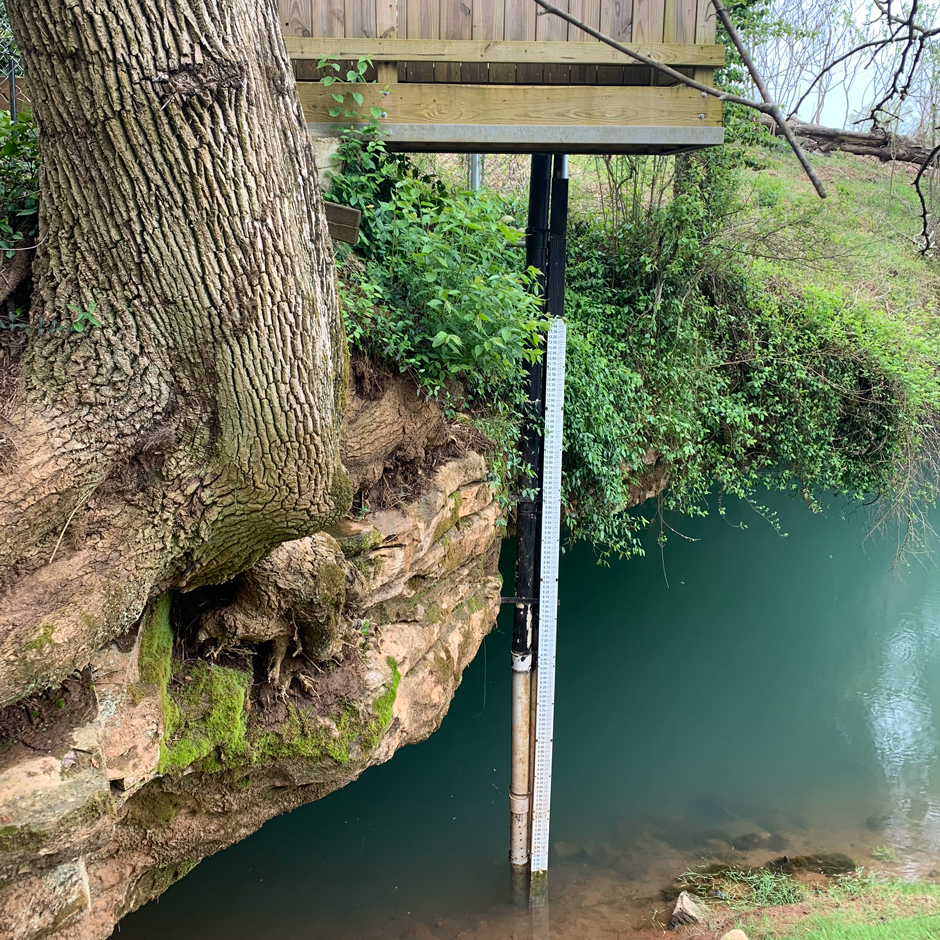 EXO II stilling well setup at Lost River Rise site. (Credit: Jason Polk / WKU CHNGES)
EXO II stilling well setup at Lost River Rise site. (Credit: Jason Polk / WKU CHNGES)Long-standing environmental monitoring programs have the power to support a large number of research initiatives and policy changes—however, actually starting these networks can prove challenging. Not only is starting the program difficult, but keeping things operational for decades to come has also been challenging for environmental professionals hoping to make an impact with applied research.
Jason Polk, Professor of Environmental Geoscience and Director of the Center for Human GeoEnvironmental Studies (CHNGES) at Western Kentucky University, is all too familiar with this process. With a background in paleoclimate research, karst environments, and reconstruction of the environment, Polk knows how important environmental monitoring is to understanding human and societal impacts as well as various environmental issues.
After completing his Ph.D., Polk started CHNGES and got more involved in emerging issues with water resources, groundwater, and karst environments where there are caves, sinkholes, springs, and underground rivers. In addition to his research, Polk teaches classes on these topics, serves on various policy-making boards, and oversees the CHNGES monitoring network.
He explains, “I do a lot of different things—and that’s really where the strength of it all is—trying to be able to put together the pieces to really fully address some of these geoenvironmental issues.”
He continues, “The coolest things I do now are the applied research projects, where we can come up with these really interesting and really innovative solutions to address things like groundwater quality issues, flooding issues, carbon transport, climate change, environmental impacts, environmental justice, and vulnerability issues.”
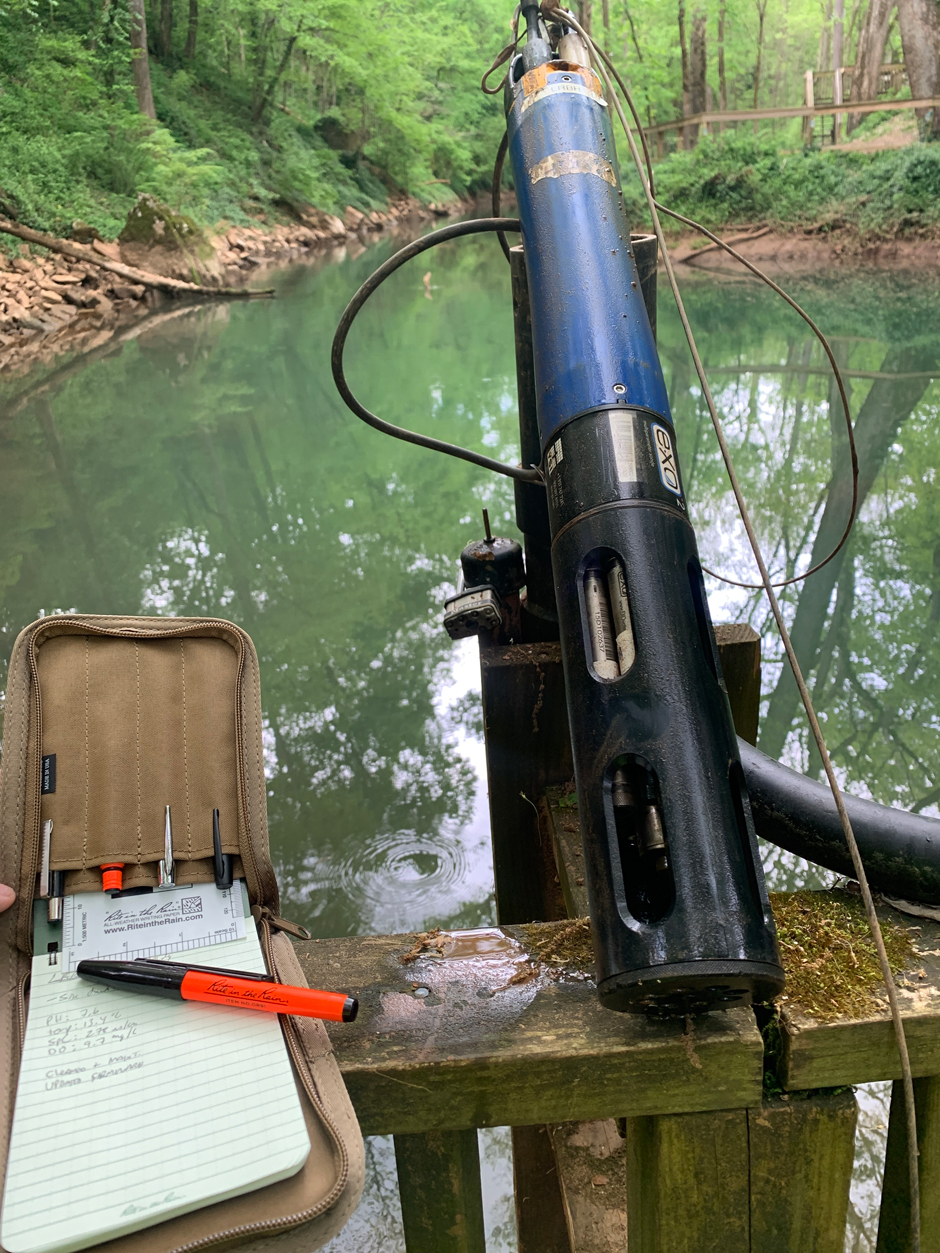
Checking the status of an EXO II at Lost River Blue Hole (Credit: Jason Polk / WKU CHNGES)
The Reach of Applied Research
All of Polk’s work revolves around these components and allows him to work on projects across the world in various fields of study. Still, the projects are all connected by applied research. As the Director of CHNGES, Polk builds monitoring networks alongside the local community to meet their needs and develop sustainable solutions.
He expands, “I can study glaciers in Iceland, I can study caves in Belize, I can study, you know, groundwater right here in Kentucky, we’ve done work with ag communities and impacts in Vietnam—it’s been really interesting and neat to be able to do work in all these different countries in these areas and see that linkage and that thread of applied research.”
A major component of Polk’s work involves educating students and giving them the opportunity to experience the full scope of applied research. Students hoping to enter the field get the chance to work with communities, partners, agencies, industries, and stakeholders. The purpose of training students with real scenarios and communities is the ability to develop and teach model practices.
Not only are the students and Polk playing an active role in the success of these programs, but they are also facilitating the implementation of these initiatives. After studying a problem and researching solutions, applied researchers actually have the opportunity to use their work.
“Instead of just sitting on a shelf somewhere, we actually get to help make changes in these places where there’s real issues through the research, through the community development, through the work—and then see that also translate into policy, or into regulation, or into just improved conditions for the people that live there,” states Polk.
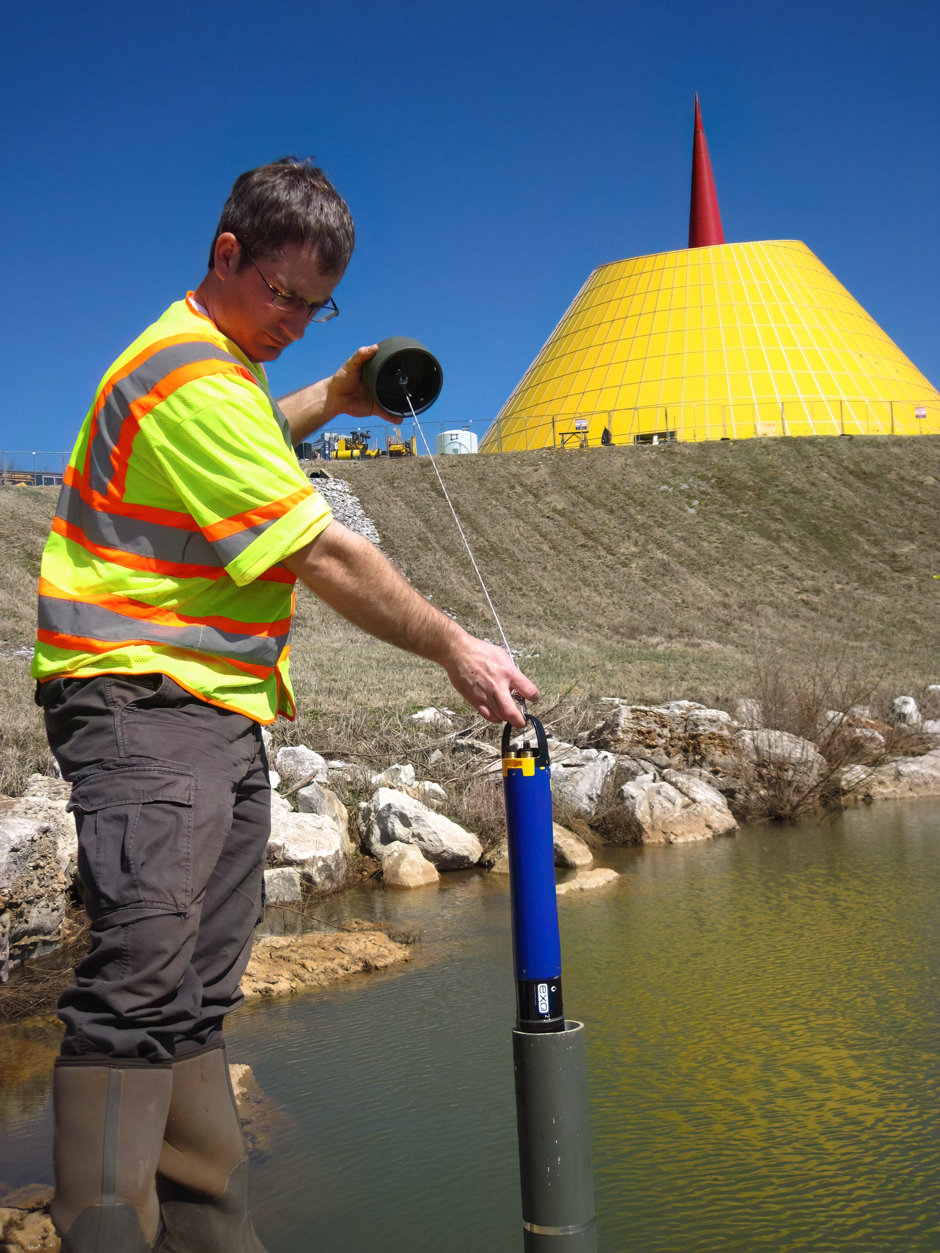
WKU CHNGES Graduate Student Dan Nedvidek deploying a sonde to monitor at the National Corvette Museum sinkhole project. (Credit: Jason Polk / WKU CHNGES)
The Influence of Applied Research
In order to effectively utilize data, Polk’s efforts go beyond his own work—extending to his students. For that reason, student training is Polk’s top priority. This training includes anticipating student needs as they go out and try to tackle real-world environmental issues, excellent field and lab work experience, and a background of data processing knowledge.
In addition to student experience, Polk spends a lot of his time working with clients and the communities in order to ensure they understand and support initiatives. Polk explains, “We work with the drivers of what we’re doing. They are the first ones that we engage with, they drive the need and give us clarity and understanding of what our mission is to best support them.”
He continues, “[What] we really want to know is: What do you need? What is the thing that you’re trying to achieve? What’s the problem that you have that you’re trying to address? From there we can really drive our applied research to focus on that outcome.”
The third variable is the longevity of the project, considering budgeting, system maintenance needs, long-term data usage and reliability, and ensuring that networks are comprised of the essential pieces with backing from interest groups. According to Polk, this step is where the creativity element comes in, and all steps are taken with the ultimate goal of sustainability.
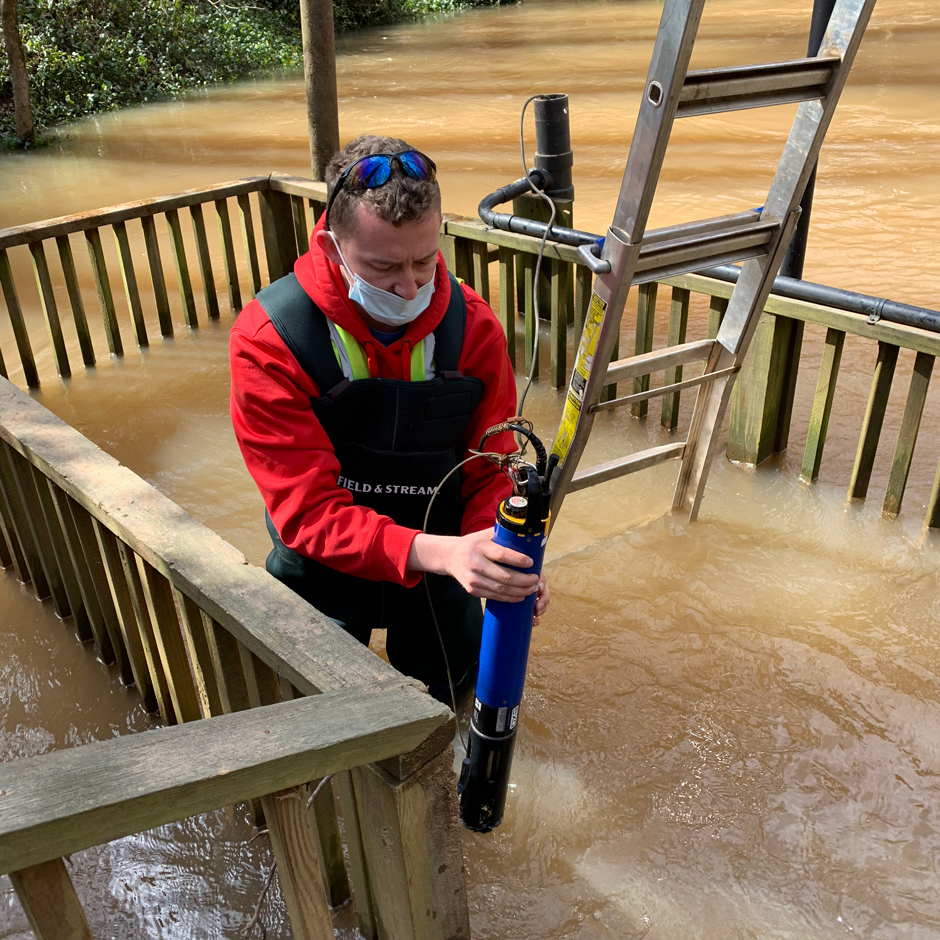
WKU Graduate Student JT Troxell checking an EXO II during a flood event. (Credit: Jason Polk / WKU CHNGES)
Environmental Monitoring Solutions for Bowling Green
One example of this is the system Polk helped construct for the city of Bowling Green. This network presented a unique challenge for Polk as it is a complex groundwater system in a fast-growing environment where the rural meets urban. Such complex systems require unique and targeted solutions that can take a long time to develop.
“We don’t go out and set up a monitoring network overnight and spend a million dollars because those two things are both really difficult to do,” states Polk.
Instead, the networks are initiated with a single comprehensive system and upgraded to include newer equipment or additional monitoring sites in order to meet data needs. In the case of Bowling Green, the initial site was a YSI EXO2 deployed in 2013, followed by upgrades or additions each year for the last decade.
Because the city has such unique environmental conditions, multiple stations can be used to collect data that paints a more comprehensive picture of conditions. As of the end of 2023, the Bowling Green network is comprised of ten YSI EXO2s, seven NexSens X2 data loggers, and a NexSens CB-150 data buoy.
Data are collected every 10 minutes and available remotely through the WQData LIVE datacenter. Most of the systems monitor pH, dissolved oxygen, specific conductivity, and turbidity, though other probes have been deployed for additional research projects.
In some cases, a system is needed in areas where a permanent system has yet to be deployed. Planning for this, the city sponsored the purchase of a mobile system that can be deployed in case of a contamination issue outside of regularly monitored areas.
Polk elaborates, “Thinking about how we tie these together, so that we can continue to do research, and we can have experience—we can use these data for all different types of things! It’s also great to have sort of instantaneous real time water quality data to monitor contamination issues, or flooding issues, or whatever the case may be.”
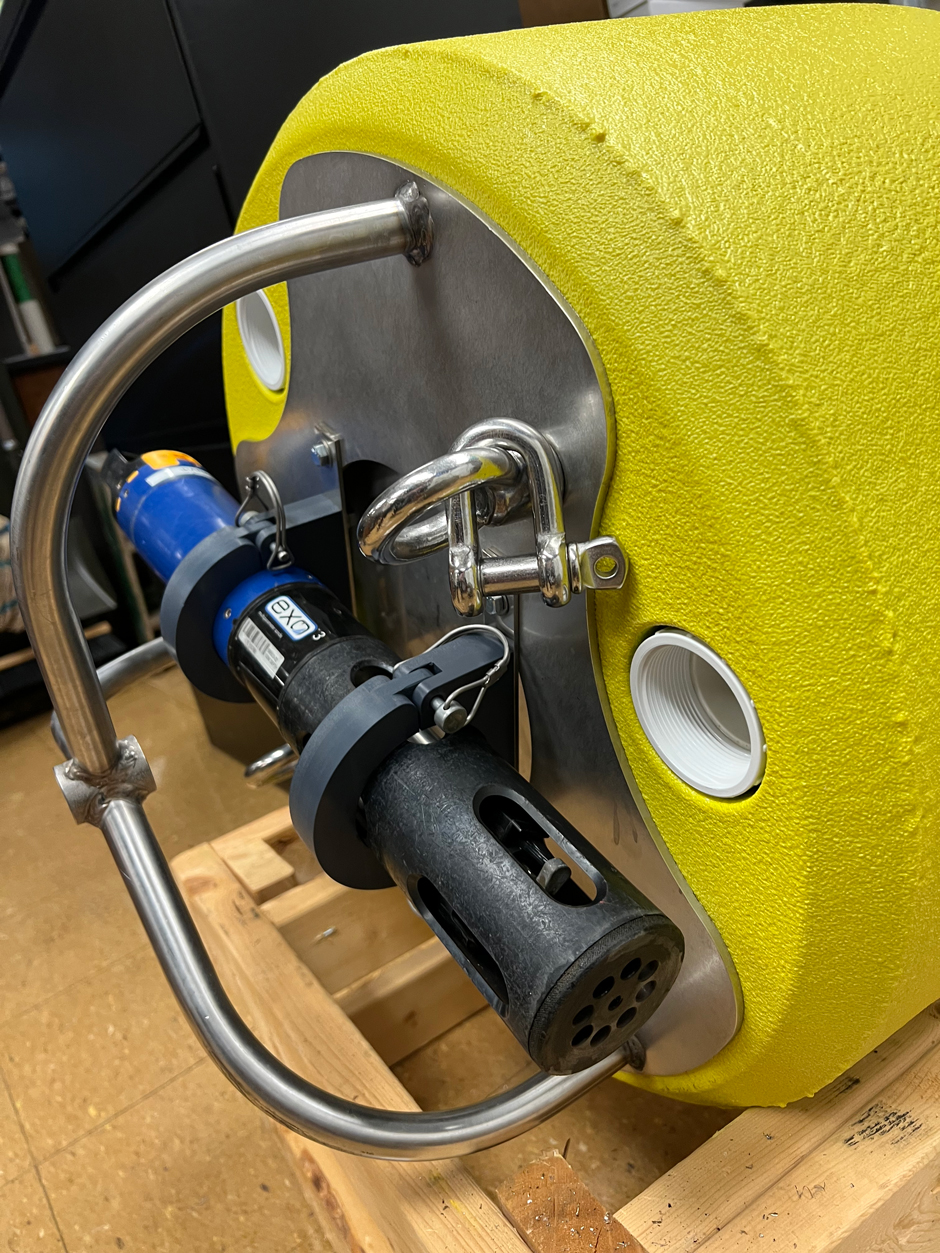
Modified NEXSENS buoy setup for an EXO I sonde deployed at the Barren River monitoring site. (Credit: Jason Polk / WKU CHNGES)
Planning for the Future
For the past 10 years, Polk and the city of Bowling Green have continued to invest time and resources into the network—not only in the form of equipment spending but also in supporting the education of generations of future environmental professionals.
A lot of the project planning research Polk engages in requires him to think about how these networks will serve communities in the future. The projects that Polk has started in his professional career have continued to grow and develop to meet future needs and have pushed him to be innovative and creative in new ways. However, the implementation of all of these ideas is a race against the clock.
He elaborates, “It’s an evolution of your career because you start these types of careers when you finish up your Ph.D. wondering if you have enough ideas, like how will I cope with new cool ideas that will sustain the next three, four decades? And then a couple of years into it, you switch and say, like, how am I going to have enough time to do all the things I have ideas for, and then they just keep coming.”
The goal of the Bowling Green initiative is to create an extensive real-time monitoring network using the best technology. The network should also serve different purposes and can be leveraged to get funds and grants, engage students, and help solve problems. Data from the system is public-facing, with the intention of being available for student research, resource managers, and any resident interested in learning more about local conditions.
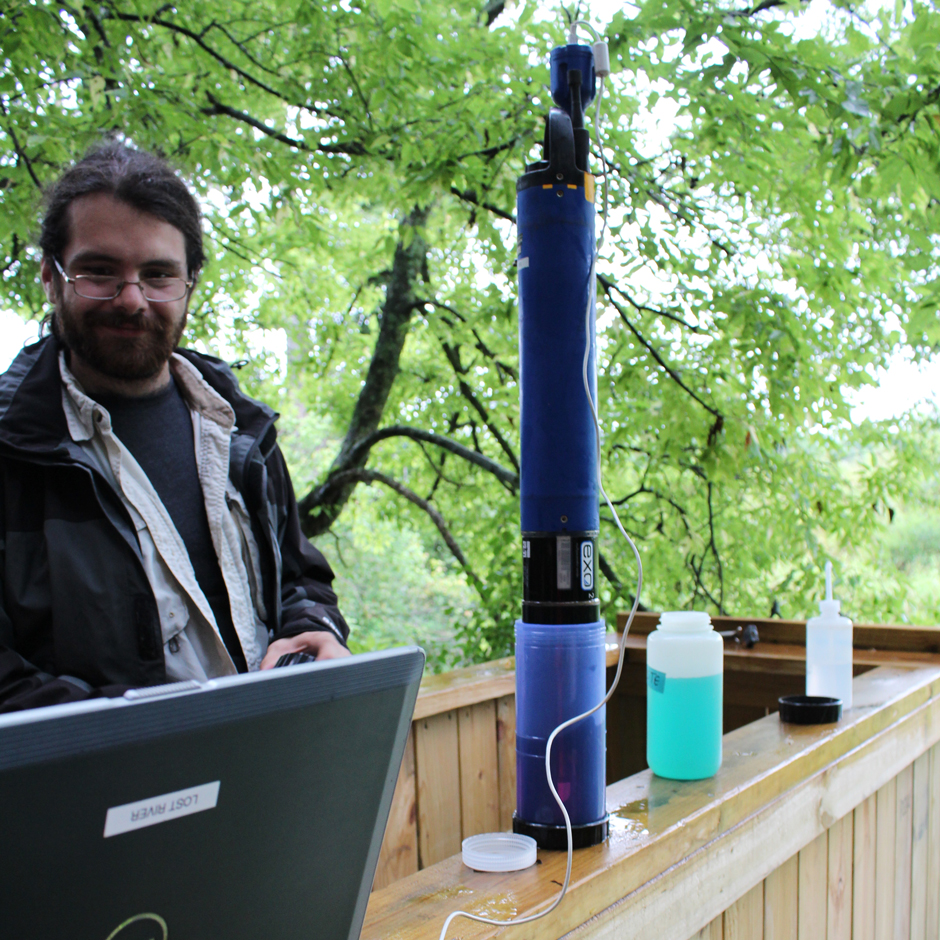
WKU CHNGES Graduate Student Bo Schaefer calibrating an EXO II sonde at Lost River Rise (Credit: Jason Polk / WKU CHNGES)
Conclusion
Moving forward, Polk hopes to get ahead of some of the regulatory changes happening and develop a more timeless network—a model system for future professionals to refer back to. In the case of his role as a professor at Western Kentucky, this includes providing opportunities for his students to grow and develop.
“I love the fact that it’s already happened several places. I’ve had several students who’ve moved into positions or transitioned into careers as consultants or with city, county, or state government, and have immediately taken these skills and been able to use them and translate them into helping those communities start the same type of network and monitoring and water quality data collection,” states Polk
The future of the network also has to consider the role of the community in shaping monitoring efforts. Public outreach is foundational to keeping the public informed of the project and receiving feedback that can guide future developments. Polk has been able to serve his community for many years thanks to great partnerships and has seen the impact of his work.
Polk explains, “The most rewarding thing about what I get to do here is to see all the effort equal the outcomes [. . .] This sort of growing network translates into the main things that are meaningful for me. It helps protect my community that I live in, the water here, and the people that live here—it helps make things safe.”
By extension, seeing his students be able to make the same difference outside of school has highlighted the importance of applied research and sharing that knowledge with future generations.
He concludes, “Once you see these possibilities, you also then get to see the rewards once you take advantage of them. So, for me, the reward every day is really just being able to know that all of the technology is being used in as many capacities as possible to help everybody at all levels—professional, community, student, stakeholder—and training those who will steward its use in the future. I think that’s the ultimate goal, you really can’t ask for more.”
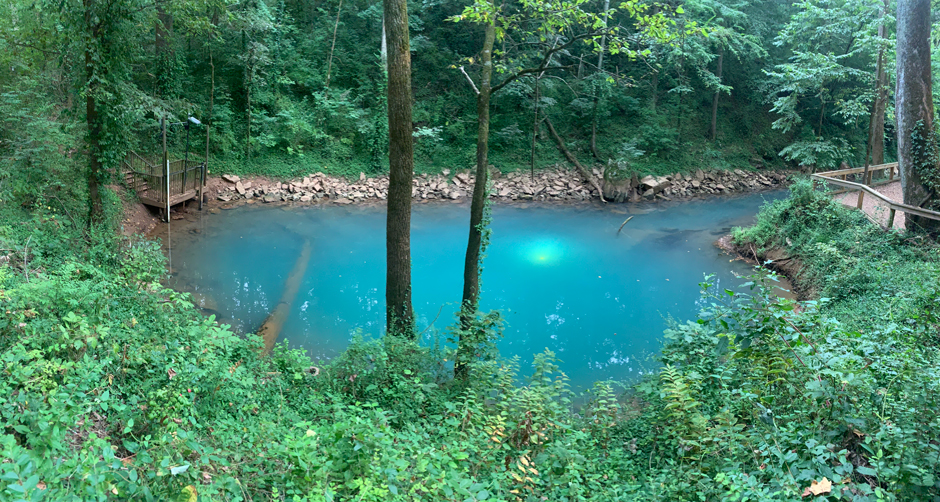
Monitoring site setup with stilling well for EXO II sonde at Lost River Blue Hole (Credit: Jason Polk / WKU CHNGES)




0 comments